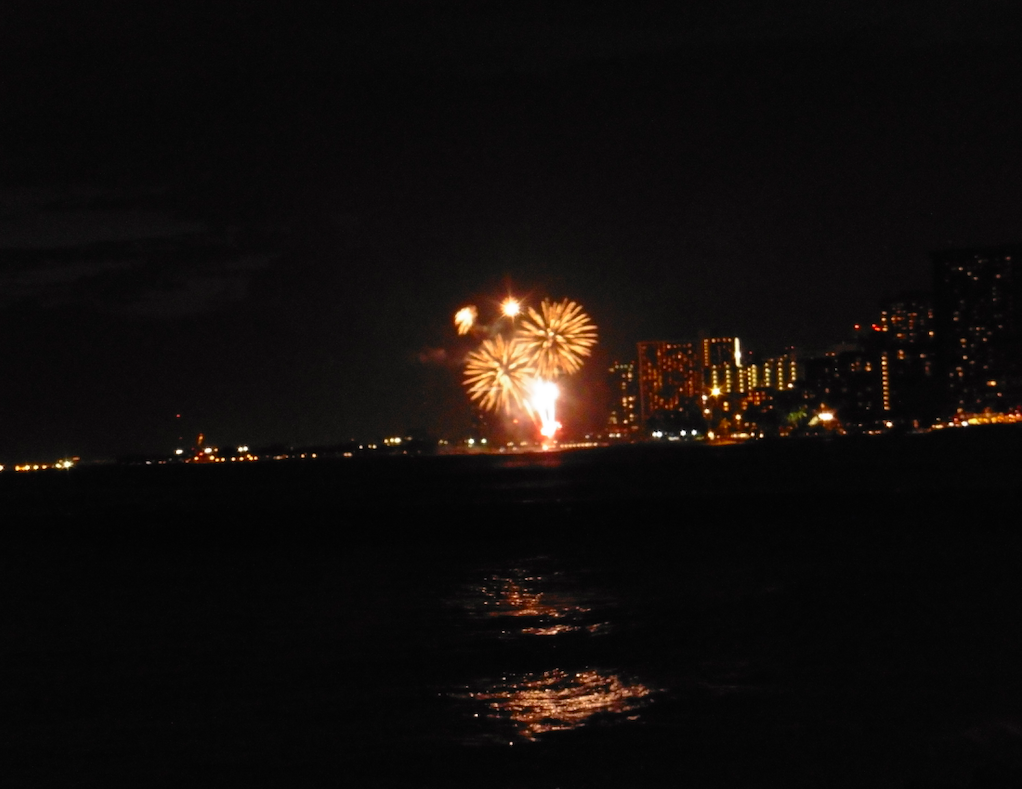This is an old revision of this page, as edited by 165.82.100.163 (talk) at 05:43, 19 February 2004 (Removed last paragraph, seemed rather "un-Misplaced Pages" (npov? US-centric)). The present address (URL) is a permanent link to this revision, which may differ significantly from the current revision.
Revision as of 05:43, 19 February 2004 by 165.82.100.163 (talk) (Removed last paragraph, seemed rather "un-Misplaced Pages" (npov? US-centric))(diff) ← Previous revision | Latest revision (diff) | Newer revision → (diff)Fireworks are explosive devices that burn with colored flames and sparks. Fireworks are used in pyrotechnic exhibitions and displays.
These devices are used in producing one or more loud bangs or striking displays of light, or a figure or figures in plain or colored fire, by the combustion of materials that burn in some peculiar manner, as gunpowder, sulfur, metallic filings, and various salts. The most common feature of fireworks is a paper or pasteboard tube filled with the combustible material. A number of these tubes or cases are often combined so as to make, when kindled, a great variety of sparkling shapes, often variously colored. The skyrocket is a common form of firework. The name is also given to various combustible preparations used in war.
Improper use of fireworks may be dangerous, both to the person operating them (risks of burns and wounds) and to bystanders; in addition, they may start a fire if landing on flammable material. For this reason, the use of fireworks is generally legally restricted. In some jurisdictions, their use is restricted to professionals; in some others, some smaller models can be used by the general public, while the others may only be operated by professionals. Also, in general, firing them near houses or in fire hazards areas is prohibited.
Home Fireworks in Britain (Guy Fawkes Night)
In 1605 Guy Fawkes and his fellow conspirators attempted to blow-up the British Parliament with 36 barrels of gunpowder in the cellars of Westminster Hall. On November 5th, Fawkes was arrested and Parliament was saved. The British people have celebrated on the night of November 5th ever since by filling the sky with exploding fireworks, by burning an effigy of Guy Fawkes on a bonfire. In more recent times legislation has controlled the way in which fireworks can be used. There have been too may injuries caused by improper use and too many household pets scared out of their wits. There is a movement to ban home use of fireworks all together and, perhaps, replace the November 5th celebration with an American-style Halloween.
Home Fireworks in the United States (Independence Day)
During the American Independence Day (popularly known as the Fourth of July), retail fireworks stands spring up around the nation in states that don't severely restrict or outright ban all fireworks for safety reasons (such as California, for example). Popular types of legal use-at-home fireworks include:
- Roman candles
- Fountain batteries (not the alkaline, DC type)
- Sparklers
- "Snakes" (turn to ash)
- Saturn missile batteries
- Smoke bombs (not an actual explosive)
Note that South Carolina sells slightly more explosive fireworks in addition to these popular types; these are usually referred to as "firecrackers". Interestingly, South Carolina also sells fireworks at stands open year-round.
In the U.S., Native American tribes that have reservation lands often sell firecrackers that are not legal for sale outside of its reservation. These include, but are not limited to:
- Cherry bombs (possibly knock-offs)
- M-80 firecrackers (possibly knock-offs)
- M-100 firecrackers (possibly knock-offs)
- M-1000 firecrackers
- "Black cat" rolls
- Mortar tubes
- Bottle rockets
Note that actual ownership or sale of true cherry bombs, M-80 style salutes, or any firecracker in excess of 50 milligrams of powder is a violation of federal law (1966 Child Protection Act). Native Americans, like any non-indigenous U.S. citizen, are not exempt from federal law. (They are exempt from other federal law! someone should check this for truth.)
Licencing for firework sellers has just been introduced in the United Kingdom due to their common misuse by children. Fireworks are now only to be sold around November 5 and New Year. Fireworks can only been sold to those aged 18 and over.
History of Fireworks
Painting |
The discovery of gunpowder and the invention of the first fireworks are traditionally credited to the Chinese, although India is also a likely source. Some scholars believe fireworks were developed in the Sui and Tang Dynasties (581-907 AD), but others believe there were no fireworks until the Northern Song Dynasty (Tenth Century AD). In the Han Dynasty (206-220 BC) firecrackers were made by roasting bamboo to produce the loud sound (known as "gung pow") that was intended to frighten evil spirits. In the Northern and Southern Dynasties (420-581 AD) the firecrackers were used not only used to dispel evil but also to pray for happiness and prosperity.
Since then, any event -- a birth, death, wedding, coronation, or New Year's celebration -- has become a fitting occasion for noisemakers.
The earliest settlers brought their enthusiasm for fireworks to this country. Firing of black powder was used to celebrate holidays. This fascination with the noise and color of fireworks continues today.
Musick for the Royal Fireworks, was composed by George Frideric Handel in 1749 to celebrate the peace of Aix-la-Chappelle, which had been declared the previous year.
Fireworks were associated with Independence Day celebrations a year after the signing of the Declaration of Independence on July 4, 1776.
By the American Revolution, fireworks had long played a part in celebrating important events. It was natural that not only John Adams, but also many of his countrymen should think of fireworks when independence was declared. The very first celebrations of Independence Day were in 1777, six years before Americans knew whether the new nation would survive the war. Fireworks were a part of these festivities. In 1789, George Washington's inauguration was also accompanied by a fireworks display.
